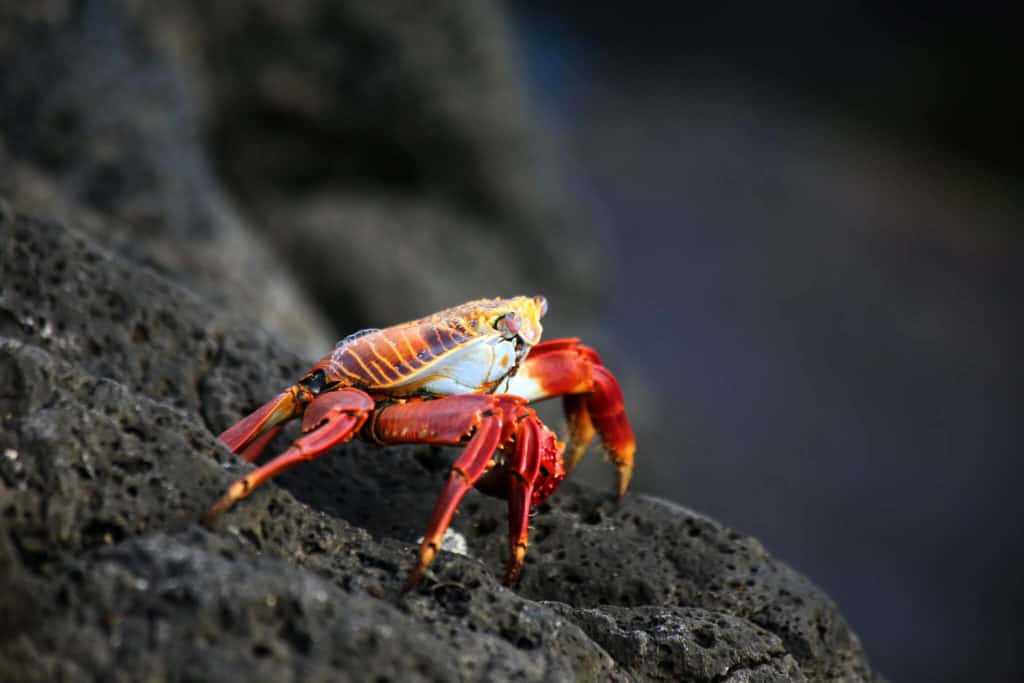Crabs are fascinating crustaceans that have tons of unique features from being able to walk in all directions, having 10 legs, and being able to lay 100,000 eggs at a time.
They can be found in oceans and freshwaters all over the world feeding on worms, fish, and even other crabs at times.
In this post, we’re going to take a closer look at how crabs navigate the vast oceans, and specifically answer do crabs swim?
In short, only some species of crab are able to swim. They are amphibious animals that generally move by walking across the ocean floor. However, some species such as the blue crab are able to swim as they have rear legs that act as paddles.
Can Crabs Really Swim?
Most species of crabs have ten legs, with the front two being claws that they use to grip things and as a form of defense.
That said, crabs of the family Portunidae have specially adapted back legs known as swimmerets. These crabs essentially have flattened back legs that act as paddles, allowing them to swim.
These legs rotate at between 20 and 40 revolutions per minute, allowing the crab to easily swim through the water.
Flower crabs, velvet crabs, Portunus crabs, and others can swim through the ocean, allowing them to stay near the surface when needed.
Check out this video of a crab swimming near the surface of the ocean:
Why Do Some Crabs Swim?
Although many crabs do not have the luxury of swimming, it is an ability that helps some crabs better traverse the ocean.
Swimming allows crabs to get over obstacles that they otherwise couldn’t, and it also helps them avoid predators that may be lurking on the ocean floor.
Scientists also believe that swimming is great for allowing crabs to relocate to other areas in search of food.
It’s also great for spreading the crab population throughout the ocean and helping the ecosystem grow.
In instances where oxygen levels in the water are too low, crabs are able to swim toward the surface in order to reach more oxygenated waters.
Do Crabs Drown?
Some species of crabs have evolved so that they can live permanently on land. They do this by ensuring that their gills stay moist.
However, if terrestrial crabs venture into the ocean, they can drown as they are not equipped to deal with life under the ocean.
Another instance where crabs may drown is when they are caught at the seaside and put into small buckets with other crabs.
A bucket full of crabs can use up the oxygen supply in the water incredibly quickly, and therefore drown when the supply runs out.
Many aquatic crabs can survive out of water for between 1 – 2 days, but as they have gills they rely on water to breathe and survive long term.
If these crabs venture too far from the ocean or get trapped on land due to the tidal movements, they may suffocate and die.
Which Way Do Crabs Swim?
Crabs are notorious for their sideways movement when walking across land. However, they are able to walk forwards, backward, and sideways too.
When it comes to swimming they have the same flexibility of movement, being able to swim in all directions as they so please.
Do Crabs Swim Upside Down?
Horseshoe crabs are crabs that are between 18 – 19 inches in size and have the remarkable ability to swim upside down.
They swim at an angle of about 30 degrees to the bottom. When they are young, they flip themselves over and use their gills as extra paddles to allow them to swim this way.
But when they grow older they tend to stay upright as most crabs do and shy away from this upside-down swimming technique.
Final Thoughts
So, do crabs swim? Yes, some species of crab have the ability to swim through the ocean, allowing them to relocate, search for food and reach more oxygenated waters.
Not all species of crab can swim, only Portunidae crabs that have specially adapted back legs that are shaped like paddles.
This allows them to push through the water and swim. It’s a great advantage that allows them to escape from predators and reach food sources that they otherwise could not.
Hopefully, you’ve learned something new today and now know why some crabs can swim but why most of them don’t have the luxury.
Thanks for taking the time to read this post and feel free to stick around to learn more about crabs and other marine wildlife.

Hi, I’m George – the founder of MarinePatch. I created this blog as marine wildlife has been my passion for many years. I’ve spent over a decade in the marine wildlife industry and spent years out in the field conducting research. In today’s modern world, an online blog is the best place for me to share my findings and reach as many people as possible to help educate and inspire others. Enjoy your time here and you’re welcome back anytime!

